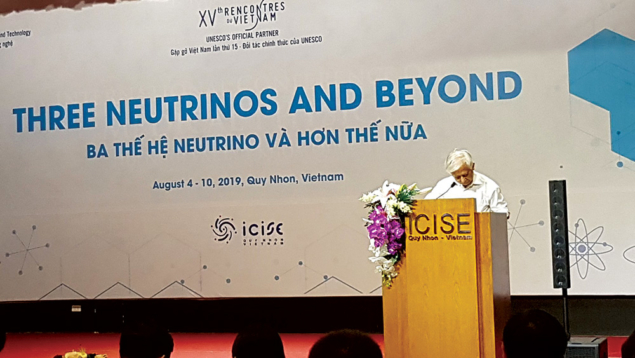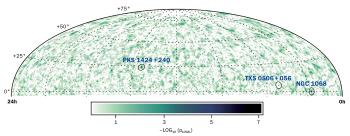
Since 1993 the Rencontres du Vietnam have fostered exchanges between scientists in the Asia-Pacific region and colleagues from other parts of the world. The 15th edition, which brought together more than 50 physicists in Quy Nhon, Vietnam from 4–10 August, celebrated the 30th anniversary of the start of the Large Electron Positron collider (LEP) in 1989, which within a mere three weeks of running had established that the number of species of light active neutrinos is three (CERN Courier September/October 2019 p32). This was a great opportunity to emphasise the important role that colliders have played and will continue to play in neutrino physics. Before the three-neutrino measurement of LEP, the tau neutrino had been established in the years 1975–1986 by a combination of e+e–-collider observations of tau decays, pp collisions (the W → τντ decay was observed at CERN in 1985) and neutrino-beam experiments, where it was observed that taus are never produced by electron– or muon–neutrino beams (for example Fermilab’s E531 experiment in 1986).
A neutrino-oscillation industry then sprang into being, following the discovery that neutrinos have mass. An abundance of recent results on oscillation parameters were presented from accelerator-neutrino beams, nuclear reactors, and atmospheric and astrophysical neutrinos. Interestingly, the data now seem to indicate at > 3σ that neutrinos follow the natural (rather than inverted) mass ordering, in which the most electron-like neutrino has a mass smaller than that of the muon and tau neutrinos. The next 10 years should see this question resolved, as well as a determination of the CP-violating phase of the neutrino-mixing matrix, with a precision of 5–10 degrees.
The fact that neutrinos have mass requires an addition to the Standard Model (SM), wherein neutrinos are massless by definition. There are several solutions, of which a minimal modification is to introduce right-handed neutrinos in addition to the normal ones, which have left-handed chirality. The properties of these heavy neutral leptons would be very well predicted were it not that their mass can lie anywhere from less than an eV to 1010 GeV or more. Being sterile they only couple to SM particles via mixing with normal neutrinos. Consequently, they should be very rare and have long lifetimes, perhaps allowing a spectacular observation in either fixed-target or high-luminosity colliders at the electroweak scale. One possible low-energy indication could be the existence of neutrinoless double-beta decay. Such decays, currently being searched for directly in dedicated experiments worldwide, violate lepton–number conservation in the case where neutrinos possess a Majorana mass term that transforms neutrinos into antineutrinos.
For a fortunate combination of parameters, this could lead to a spectacular signature
The meeting reviewed the status of all aspects of massive neutrinos, from direct mass measurements of the sort successfully executed shortly after the conference by the KATRIN experiment (see KATRIN sets first limit on neutrino mass) to the search for heavy sterile neutrinos in ATLAS and CMS. A new feature of the field is the abundance of experimental projects searching for very weakly, or, to use the newly coined parlance, “feebly”, interacting particles. These range from CERN’s SHiP experiment to future LHC projects such as FASER and Mathusla (for masses from the pion to the B meson); proposed high-luminosity and high-energy colliders such as the Future Circular Collider would extend the search up to the Z mass for mixings between the heavy and light neutrinos down to 10–11. Until recently classified as exotic, these experiments could yield the long-sought-after explanation for the matter–antimatter asymmetry of the universe by combining CP violation with an interaction that transforms particles into antiparticles. For a fortunate combination of parameters, this could lead to a spectacular signature: the production of a heavy neutrino in a W decay, tagged by an associated charged lepton, and followed by its transformation into its antineutrino, which could then be identified by its decay into a lepton of the same sign as that initially tagged (and possibly of a different flavour).
The meeting was thus concluded in continuity with its initial commemoration: could the physics of neutrinos be one of the highlights of future high-energy colliders?







